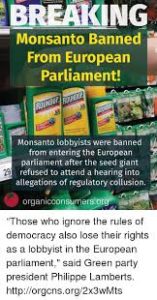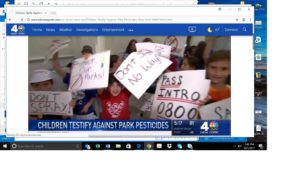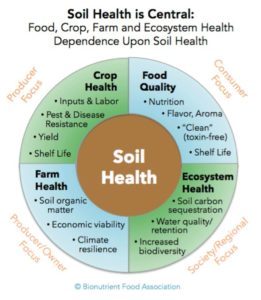(Beyond Pesticides, October 25, 2017)Â Oregon is the most recent site of an effort by a locality to establish more-protective pesticide regulations than are provided by the state. Voters in Lincoln County, on the north-central  Oregon Coast, approved a ballot measure earlier this year that established a ban on aerial spraying of pesticides in the county. Immediately, county landowners Rex Capri and Wakefield Farms, LLC, both of whom use aerial spraying on their properties, filed a legal challenge to the ordinance created through that vote. The issue is whether the state of Oregon has the legal authority to stop its local political subdivisions from adopting more rigorous than those enacted by the state.
Oregon Coast, approved a ballot measure earlier this year that established a ban on aerial spraying of pesticides in the county. Immediately, county landowners Rex Capri and Wakefield Farms, LLC, both of whom use aerial spraying on their properties, filed a legal challenge to the ordinance created through that vote. The issue is whether the state of Oregon has the legal authority to stop its local political subdivisions from adopting more rigorous than those enacted by the state.
When the state of Maine considered legislation to preempt its local jurisdictions (take away their authority to act) this summer, Beyond Pesticides wrote, âThe democratic process is foundational to the culture of Maine and the country. LD 1505 betrays the democratic process. Maine communities want to be able to adopt standards that exceed or are more stringent than state standards as a matter of public health and environmental protection, or quality of life. Why would a town or city want to do use its local authority to adopt a pesticide restriction? It is the simple exercise of the local democratic process that, while meeting state and federal standards, decides that it wants to do more to protect the health of families, children, local waterways, pollinators, and those with pre-existing medical conditions that are exacerbated by pesticide exposure.â
The Oregon case began its hearing in early October before Lincoln County Circuit Court Judge Sheryl Bachart, who says she expects to issue a written ruling soon. The plaintiffsâ attorney, Gregory Chaimov, argues that the county lacks the authority to create such an ordinance, that local statute cannot override state law, and that the ban is barred by state regulations governing use of âpesticides, forestry practices, and the âright to farm.ââ
Lincoln County Community Rights (LCCR), a nonprofit that intervened as a defendant in the case, counters that people, in this case in the form of the county, have the inherent right to community self-governance, and should be able to protect themselves and their community from âtoxic trespassâ from aerial pesticide applications. The group says that the state legislature does not have the authority to establish a âceilingâ that would proscribe more-protective local regulations on health and safety than the state sets out. On those grounds, LCCR also argues that any Oregon law that would prevent local governments from regulating pesticides use is unconstitutional. In a local newspaper, LCCR stated, âThe [plaintiffsâ] preemption complaint boils down to asserting there is a greater legal authority for Capri, Wakefield Farms, and others to aerial spray than for the people of Lincoln County to ban aerial spraying on the grounds of protecting the right not to be toxically trespassed, the right to clean water free from aerial sprayed pesticides, and the rights of the ecosystems not to be exposed to aerial sprayed pesticides.â
Ann Kneeland, LCCR attorney, maintains that the Oregon Constitution places all authority in the people, ââwho may reform or abolish the government. . . . The countyâs power to self-govern derives directly from the Oregon Constitution, therefore it supersedes state laws that limit the authority of local governments. These concepts may seem radical or revolutionary to us now but these are concepts in our Constitution.ââ
The case points to the legal conundrum that localities face in trying to protect their residents, lands, and resources from the assaults of pesticides, GMOs (genetically modified organisms), factory farms, fracking sites, or a host of other ills that communities may find objectionable because of health, safety, and/or environmental concerns. As communities (in the form of towns, counties, or cities) initiate efforts to establish regulations that may be more protective than prevailing state laws are, states and, very often, corporations persistently challenge those initiatives, arguing that state statutes supersede local authority to regulate. Such deference to state authority and statute is referred to as preemption â the use of state law to nullify the authority of a âlowerâ level of government, or a specific statute or ordinance, on that preemptive basis.
There are several types of preemption that states employ: (1) express preemption, or the prohibition of local governments from regulating in a specific area; (2) implied preemption, wherein âstate laws give the impression that the intent of the state was to occupy the field and exclude local ordinancesâ; and (3) preemption by conflict, which happens when a local ordinance either prohibits or allows an activity permitted or prohibited, respectively, by state statute. Another definitional note: there are âceiling preemptionsâ and âfloor preemptions,â the former being federal or state laws that establish a maximum level of protection for peopleâs safety, health, well-being, and rights, and the latter establishing a minimum level of protection, above which local regulations can create greater protections.
As communities become more aware of and concerned about unsafe, harmful, or objectionable actions in their localities, peopleâs interest in local control and authority has grown considerably. The Community Environmental Legal Defense Fund (CELDF), which advocates for greater local authority over what affects the welfare of communities, has grown alongside this awareness and interest. As noted in the Beyond Pesticidesâ factsheet on preemption, âAs pesticide pollution and concerns over the effects of GE foods on human and environmental health mount, many are fighting to overturn preemption laws and return the power back to localities, enabling them to adopt more stringent protective standards throughout their communities.â
The notion that communities should be able to protect themselves may seem obvious on the surface, but doing so in the face of inevitable challenges is a legal minefield that involves state constitutions, legal âauthority,â precedent, and corporate influence. CELDF approaches these issues from a stance of establishing both the rights, and the legal authority, to protect. The group says, âWe assist communities to develop first-in-the-nation, groundbreaking laws to protect rights â including worker, environmental, and democratic rights, and rights of nature. . . . [We do so] because the existing structure of law ensures that people cannot govern their own communities and act as stewards of the environment, while [it protects] corporate ârightsâ and interests over those of communities and nature.â
The tension between statesâ preemptive authority, and the emerging insistence on greater local control to protect its residents, goes to the very heart of not only how governments at state and local levels derive their authority in a democratic system, but also, how that authority is shared â or not. The Supremacy Clause of the U.S. Constitution (Article VI, Clause 2) clearly establishes that the Constitution, federal laws made pursuant to it, and treaties made under its authority, constitute the supreme law of the land. At the state level, things can become a bit less clear. Each state has its own Constitution, of course, its own interpretive history of the document, and its own assignations of authority regarding the host of issues with which governments concern themselves.
In the collage of various state approaches to pesticide regulation, Beyond Pesticides notes that 43 states currently exercise some form of preemption vis a vis local statutes; 14 have no explicit preemption language, but assign the authority for pesticide regulation to an agriculture department, commissioner, or pesticide board; and only seven states have no preemption laws. It is noteworthy that 29 states that set out preemptive provisions use virtually the same language in their statutes. This is evidence of industry influence on legislatures, wherein lobbyists create âmodel legislationâ that corporations want adopted, lobbyists meet with legislators with template laws in hand, and legislators â some of whose bread is considerably buttered by industries â then push for adoption of the legislation.
This is precisely the method for which ALEC, the American Legislative Exchange Council â a consortium of conservative state legislators and private sector representatives (aka corporate lobbyists) â has become infamous. Ms. Kneeland said that state lawmakers try to limit localitiesâ constitutional ability to create stronger protections ââat the behest of well-funded corporate interests. . . . We find ourselves in a legal system where corporations consistently have greater rights than the people.ââ
A 2017 National League of Cities report, City Rights in an Era of Preemption: A State-by-State Analysis, points out that. âState legislatures have gotten more aggressive in their use of preemption in recent years. Explanations for this increase include lobbying efforts by special interests, spatial sorting of political preferences between urban and rural areas, and single party dominance in most state governments. . . . This loss of local control means that cities cannot curtail laws to fit their needs.â
A bit of history on preemption in the realm of pesticide regulation: In 1991, the U.S. Supreme Court (SCOTUS) ruled in Wisconsin Public Intervenor v. Mortier, that the federal law known as FIFRA â the Federal Insecticide, Fungicide and Rodenticide Act â does not preempt local jurisdictions from creating more-stringent pesticide regulation. Thus, it was ruled that FIFRA nowhere expressly supersedes local regulation. However, and critically, the court left intact the ability of states to preempt such regulations.
The pesticide industry has been very active in seeking federal legislation that preempts the ability of states to adopt more stringent standards, and has tried repeatedly to preempt the rights of states to adopt more-stringent regulations under FIFRA. After the SCOTUS Mortier decision, the Coalition for Sensible Pesticide Policy (comprising pesticide industry lobbyists) formed and drafted model legislation that would restrict municipalities from creating ordinances that would regulate use of pesticides on private property, and advocated for it methodically â and successfully â in many states.
In the face of this preemption hurdle, there have been numerous efforts on the parts of municipalities to enact stronger-than-the-stateâs protections from pesticides (including herbicides and fungicides). Early on, in 1979, Mendocino, California tried to prevent aerial application of phenoxy herbicides through local statute; a California Supreme Court upheld it in 1984, and then the legislature passed a law to preempt the action.
In 2013, Kaui County, Hawaii attempted to regulate GMOs and pesticide application by requiring notification before pesticide use and mandating buffer zones. Paul Goeringer writes in his Maryland Risk Management Education blog, âBecause state pesticide law enables the state Department of Agriculture to establish regulations regarding pesticides, the court found that the Kuai County effort to regulate âtouched uponâ the same subject matter as Hawaiiâs pesticide law, and therefore, should be preempted; when the county argued that, essentially, there were matters unaddressed by the state law, the court found that the âdepthâ of the state statute demonstrated that it was comprehensive and thus, functionally âimpenetrableâ to local control.â
In 2015, Montgomery County, Maryland established an ordinance which could require posted notice of some lawn applications of pesticides, prohibit certain pesticides on lawns and county-owned property, and require the county to adopt integrated pest management (IPM) on certain county-owned properties. This past August, a Montgomery County Circuit Court struck down components of the ordinance, eliminating pesticide use restrictions on private property, but left intact provisions limiting toxic pesticides used on public, county-owned land.
Beyond Pesticides executive director Jay Feldman said of the Maryland case, âThe court should have recognized that, in restricting lawn pesticides throughout its jurisdiction, Montgomery County is exercising a local democratic principle under Maryland and federal law to ensure the safety of the community, including children, pets, and the environment, from a known hazard not adequately regulated by the U.S. Environmental Protection Agency or the state. . . . After extensive hearings and study, the county council understands that toxic chemicals are dangerous and not needed to have beautiful lawns and landscapes. Just like big tobaccoâs attacks on local smoking restrictions to control secondhand smoke, the chemical industry is attempting to head off a growing movement asking for common-sense measures that protect public health from pesticide exposure.â Montgomery County is appealing the Circuit Court ruling.
In its State Preemption Law factsheet, Beyond Pesticides has further noted that, âNumerous studies by the U.S. Government Accountability Office and scientific studies indicate that federal and state governments alone are not adequately protective of health and the environment. There is no evidence that the prospect of local democratic decision making is a threat to agriculture or other business interest[s] in local communities. In fact, those closely aligned with these interests are well represented in local decision making bodies. Finally, local legislators know that restricting pesticides is no different from other environmental and neighborhood stewardship laws, including restrictions on littering, recycling, noise, picking up after pets, and smoking. These local laws all act on values associated with living in a community where contaminant-free air, water, and land are shared resources.â
Beyond Pesticides has long maintained the importance of the rights of local governments to protect public health and the environment â particularly when federal and state government are not adequately protective. State preemption often denies people their democratic right to better protection when a community decides that minimum standards set by state and federal law are insufficient. Localities across the country continue the work to pass statutes that would better protect residents and resources. A snapshot of the status of local policies on pesticide use is provided by the Beyond Pesticides and Organic Consumers Association in the map of U.S. Pesticide Reform Policies.
All unattributed positions and opinions in this piece are those of Beyond Pesticides.
Source: http://www.capitalpress.com/Oregon/20171009/oregon-countys-aerial-spray-ban-gets-day-in-court
 (Beyond Pesticides, October 31, 2017) Scientists warn that inadequate federal testing, disproportionate industry influence, and subverted regulatory oversight threaten decades of progress on protecting people from hormone disrupting chemicals. This from a new paper with findings that regulators face a critical need to fully understand and address the hazards from these dangerous substances.
(Beyond Pesticides, October 31, 2017) Scientists warn that inadequate federal testing, disproportionate industry influence, and subverted regulatory oversight threaten decades of progress on protecting people from hormone disrupting chemicals. This from a new paper with findings that regulators face a critical need to fully understand and address the hazards from these dangerous substances.








 Comment period closes today, Monday, October 30, 2017, at 4:30pm (Eastern Time). Your comments are needed to stop the disaster in Arkansas being created by Monsantoâs new genetically engineered (GE) cropping system, which relies on the toxic pesticide dicamba.
Comment period closes today, Monday, October 30, 2017, at 4:30pm (Eastern Time). Your comments are needed to stop the disaster in Arkansas being created by Monsantoâs new genetically engineered (GE) cropping system, which relies on the toxic pesticide dicamba. Amherst identify a novel approach to reduce toxic pesticide residues on conventional food. The method the authors describe is cumbersome and unlikely to be widely used by consumers. At the same time, study results confirm that eating organic products is the best way for individuals and families to eliminate pesticide residues from their diet.
Amherst identify a novel approach to reduce toxic pesticide residues on conventional food. The method the authors describe is cumbersome and unlikely to be widely used by consumers. At the same time, study results confirm that eating organic products is the best way for individuals and families to eliminate pesticide residues from their diet. to stop the practice â often referred to as âsue and settleâ â of settling lawsuits with outside (often, environmental) groups. Itâs the Administratorâs contention that such groups have had undue influence on regulation.
to stop the practice â often referred to as âsue and settleâ â of settling lawsuits with outside (often, environmental) groups. Itâs the Administratorâs contention that such groups have had undue influence on regulation.  Oregon Coast, approved a ballot measure earlier this year that established a ban on aerial spraying of pesticides in the county. Immediately, county landowners Rex Capri and Wakefield Farms, LLC, both of whom use aerial spraying on their properties, filed a legal challenge to the ordinance created through that vote. The issue is whether the state of Oregon has the legal authority to stop its local political subdivisions from adopting more rigorous than those enacted by the state.
Oregon Coast, approved a ballot measure earlier this year that established a ban on aerial spraying of pesticides in the county. Immediately, county landowners Rex Capri and Wakefield Farms, LLC, both of whom use aerial spraying on their properties, filed a legal challenge to the ordinance created through that vote. The issue is whether the state of Oregon has the legal authority to stop its local political subdivisions from adopting more rigorous than those enacted by the state. dramatic drop in insect biomass has led to equally dramatic pronunciations from highly respected scientists and entomologists. âWe appear to be making vast tracts of land inhospitable to most forms of life, and are currently on course for ecological Armageddon,â study coauthor David Goulson, Ph.D. of Sussex University, UK, told The Guardian. âIf we lose the insects then everything is going to collapse.â Looking at the range of mechanisms that could be driving this slow moving catastrophe, researchers could suss out only one plausible large-scale factor: agricultural intensification.
dramatic drop in insect biomass has led to equally dramatic pronunciations from highly respected scientists and entomologists. âWe appear to be making vast tracts of land inhospitable to most forms of life, and are currently on course for ecological Armageddon,â study coauthor David Goulson, Ph.D. of Sussex University, UK, told The Guardian. âIf we lose the insects then everything is going to collapse.â Looking at the range of mechanisms that could be driving this slow moving catastrophe, researchers could suss out only one plausible large-scale factor: agricultural intensification. imidacloprid. AÂ
imidacloprid. AÂ  to minimize drift that has left thousands of acres of crops already damaged this season. The label changes include making dicamba ârestricted use,â which allows only certified applicators to apply the chemical. Dicamba drift has been damaging farmers’ crops for at least two years due to the approval of new dicamba-tolerant genetically engineered (GE) crops. Advocates says that the new changes do not ensure that drift will be eliminated.
to minimize drift that has left thousands of acres of crops already damaged this season. The label changes include making dicamba ârestricted use,â which allows only certified applicators to apply the chemical. Dicamba drift has been damaging farmers’ crops for at least two years due to the approval of new dicamba-tolerant genetically engineered (GE) crops. Advocates says that the new changes do not ensure that drift will be eliminated. cricket frogs, according to researchers from Ohioâs Miami University. While it may be ostensibly easy to dismiss the results of this study as limited to a single frog species, the Blanchard cricket frog, with its populations concentrated in heavily farmed Midwestern states, is likely an important indicator of broader ecological impacts. Ultimately, only a transition away from toxic herbicides and towards integrated organic systems will successfully address the ongoing effects of industrial agrichemicals on amphibians.
cricket frogs, according to researchers from Ohioâs Miami University. While it may be ostensibly easy to dismiss the results of this study as limited to a single frog species, the Blanchard cricket frog, with its populations concentrated in heavily farmed Midwestern states, is likely an important indicator of broader ecological impacts. Ultimately, only a transition away from toxic herbicides and towards integrated organic systems will successfully address the ongoing effects of industrial agrichemicals on amphibians. meetings and digital resources, as well as no longer permitting Monsanto lobbyists to meet with any Member of the European Parliament (MEP). This limit to its influence is a serious blow to Monsantoâs advocacy campaign to promote the safety of its weedkiller
meetings and digital resources, as well as no longer permitting Monsanto lobbyists to meet with any Member of the European Parliament (MEP). This limit to its influence is a serious blow to Monsantoâs advocacy campaign to promote the safety of its weedkiller  risks after it was learned that the paper was secretly edited and funded by Monsanto.
risks after it was learned that the paper was secretly edited and funded by Monsanto.
 (Beyond Pesticides, October 13, 2017) The U.S. Environmental Protection Agency (EPA) can better reduce risks from illegal pesticides by effectively identifying imports for inspection and sampling. This, according to a report from EPAâs Office of the Inspector General (OIG) released last month. The report finds low rates of inspection and sampling across the U.S. to stop the importation of pesticide products that violate federal laws, and recommends increased training and coordination between U.S. Customs and Border Protection to deter the import of harmful pesticides.
(Beyond Pesticides, October 13, 2017) The U.S. Environmental Protection Agency (EPA) can better reduce risks from illegal pesticides by effectively identifying imports for inspection and sampling. This, according to a report from EPAâs Office of the Inspector General (OIG) released last month. The report finds low rates of inspection and sampling across the U.S. to stop the importation of pesticide products that violate federal laws, and recommends increased training and coordination between U.S. Customs and Border Protection to deter the import of harmful pesticides. The extent of contamination recorded in the new
The extent of contamination recorded in the new  pesticides – acetamiprid, dinotefuran, and imidacloprid, and the agencyâs failure to first consult with the U.S. Fish and Wildlife Service on the pesticidesâ impact on threatened or endangered species.
pesticides – acetamiprid, dinotefuran, and imidacloprid, and the agencyâs failure to first consult with the U.S. Fish and Wildlife Service on the pesticidesâ impact on threatened or endangered species. In addition to the other priorities in our previous alert (
In addition to the other priorities in our previous alert ( published by Dutch social scientists. Organic food products are
published by Dutch social scientists. Organic food products are  childhood brain tumors in children. According to the study, mothers who use pesticides in the home while pregnant put their children at 1.4 times the risk of developing a brain tumor under the age of 15. The study findings point to the need to eliminate the residential use of toxic chemicals by increasing education around alternative pest management practices in the home and garden, as well as regulatory action to remove toxic pesticides from the market.
childhood brain tumors in children. According to the study, mothers who use pesticides in the home while pregnant put their children at 1.4 times the risk of developing a brain tumor under the age of 15. The study findings point to the need to eliminate the residential use of toxic chemicals by increasing education around alternative pest management practices in the home and garden, as well as regulatory action to remove toxic pesticides from the market. uniforms. They superficially resemble fireflies (family Lampyridae), but lack light-emitting organs and the covering obscuring the head of fireflies. Like fireflies, soldier beetles are distasteful to most predators.
uniforms. They superficially resemble fireflies (family Lampyridae), but lack light-emitting organs and the covering obscuring the head of fireflies. Like fireflies, soldier beetles are distasteful to most predators. abruptly postponed on August 19, with no reason offered, and has not yet been rescheduled.
abruptly postponed on August 19, with no reason offered, and has not yet been rescheduled. bill introduced by Manhattan Councilmember Ben Kallos. âWeâre going to make a great big fuss,â the children in Mrs. Paula Rogivinâs kindergarten class
bill introduced by Manhattan Councilmember Ben Kallos. âWeâre going to make a great big fuss,â the children in Mrs. Paula Rogivinâs kindergarten class  sustainability. That is the take from aÂ
sustainability. That is the take from a 

